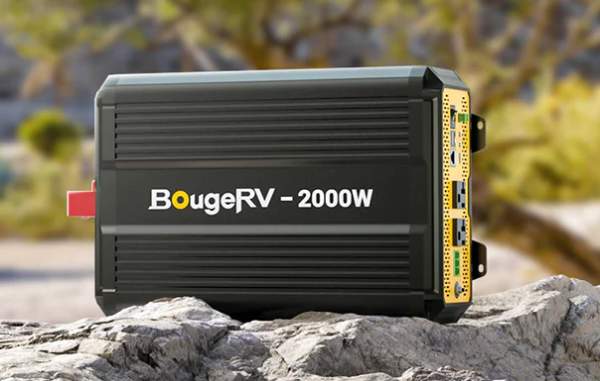How to Choose the Right Off-Grid Inverter?

Looking to break free from the regular power grid? Picking the right off-grid inverter is key. Inverters are the heart of any off-grid power setup, transforming DC power from batteries into AC power for household use. A dependable inverter ensures that your off-grid experience is seamless, providing the comforts of modern living without the grid connection.
In this blog, we'll walk you through everything you need to know to choose a solid inverter that'll keep your off-grid setup running smoothly. This comprehensive guide will cover the basics of off-grid inverters, help you determine your power requirements, explore features to consider when choosing an inverter, and provide insights into installation, budget, and avoiding common mistakes.
Let's get powered up with the info you need to make a smart choice for your energy independence!
Basics of Off-Grid Inverters

When selecting an off-grid inverter, understanding the basics is essential for a reliable and efficient energy system:
What are Off-Grid Inverters? What Are They Used for?
Off-grid inverters are crucial components in standalone power systems that do not connect to the traditional electrical grid. These devices convert direct current (DC) from batteries or renewable energy sources like solar panels into alternating current (AC), which is the standard used by most household appliances and electronics.
Without an inverter, the DC power generated by your off-grid setup would be incompatible with everyday AC devices.
Key Differences Between Off-Grid and Grid-Tied Inverters
The main distinction between off-grid and grid-tied inverters lies in their interaction with the electrical grid. Off-grid inverters work independently and must handle all the energy conversion and management needs within the system. They are also designed to interface directly with batteries, whereas grid-tied inverters send excess power back to the grid and draw from it when necessary—something off-grid systems don't have the luxury to do. Additionally, off-grid inverters must be able to manage fluctuations in power generation and demand without grid support.
Types of Off-Grid Inverters
- Pure Sine Wave Inverters
These inverters produce a smooth and consistent sine wave, closely matching the power quality of the grid. They are ideal for running sensitive electronic equipment without risk of damage or interference. Although they tend to be more expensive, their efficiency and ability to cleanly power a wide range of appliances make them a preferred choice for many off-grid systems.
- Modified Sine Wave Inverters
A more cost-effective option compared to pure sine wave inverters, modified sine wave inverters produce a simpler, stepped approximation of a sine wave. While suitable for many basic appliances and tools, they may cause issues with more delicate electronics or devices that require a high-quality power source.
- Hybrid Inverters
Hybrid inverters combine the functionality of a standard inverter with a battery charger and can connect to the grid if available. This flexibility allows for battery charging from either the grid or renewable sources and enables the system to function as both off-grid and grid-tied under different circumstances. They are an excellent choice for systems where grid connection might be intermittent or as backup power solutions.
To choose the right inverter, it's essential to understand its purpose and variations.
The main difference lies in grid connectivity; off-grid inverters operate independently, while grid-tied inverters work in sync with the utility grid.
Determining Your Power Requirements
- Calculating Your Total Energy Consumption
Begin by listing all the electrical appliances and devices you plan to use, noting their power ratings typically in watts (W) or kilowatts (kW). Calculate the daily energy consumption for each item by multiplying its power rating by the number of hours it will be used per day. Summing up these values gives you an estimate of your total daily energy usage in kilowatt-hours (kWh), which is crucial in determining the size of your inverter and battery bank.
- Understanding Continuous vs. Peak Power Demands
Your inverter must be capable of supplying two types of power demands: continuous and peak. Continuous power is the steady amount of electricity your appliances draw while operating normally. Peak or surge power is the higher load that some appliances, like refrigerators or pumps, require at startup. This surge can be several times the continuous rating and usually lasts for a short period. Your inverter should have a peak power rating that exceeds the highest surge demand in your system.
- The Significance of Sizing Your Inverter Correctly
Sizing your inverter correctly is paramount to prevent overloading and potential damage. An undersized inverter will continuously trip or shut down, while an oversized one can be less efficient and less cost-effective. Consider both your current and future power needs, allowing for potential expansion or additional appliance usage. A suitably sized inverter will operate efficiently, handle your energy demands, and adapt to any changes in your power consumption patterns.
By carefully calculating your total energy consumption, understanding your continuous versus peak power demands, and recognizing the importance of proper inverter sizing, you'll be well-equipped to select an inverter that aligns with your off-grid energy system's requirements.
Features to Consider When Choosing an Off-Grid Inverter

Several factors influence inverter performance and suitability, including efficiency and performance metrics, battery compatibility with the inverter, quality, and safety certifications.
By thoroughly evaluating these features, you'll be able to choose an off-grid inverter that suits your specific situation, ensuring a resilient and sustainable off-grid energy system.
1. Efficiency and Performance Metrics
Opt for inverters with high-efficiency ratings to maximize your system's output.
Inverter efficiency indicates how much input energy from your batteries is successfully converted into usable AC power. A higher efficiency rating means less energy is lost during this conversion process. Performance metrics also include the inverter's power factor, no-load draw, and its ability to handle surges when appliances start. The inverter must maintain a high performance while minimizing energy losses.
2. Inverter Battery Compatibility
Ensure the inverter matches the voltage of your battery bank and can handle its capacity.
The inverter must be compatible with your battery bank's voltage and type (e.g., lead-acid, lithium-ion). Some inverters are designed specifically for certain battery chemistries and capacities, optimizing charging algorithms and extending battery life. Ensure that the inverter's charge controller matches the needs of your batteries to prevent overcharging or undercharging.
3. Quality and Safety Certifications
Look for inverters that have passed rigorous testing and hold quality and safety certifications, such as UL, ETL, or CE. These certifications indicate that the product meets strict safety standards and is reliable.
4. Environmental Considerations and Operating Temperature Range
Your inverter should be able to withstand the environmental conditions where it will be used. Check the operating temperature range, and make sure it can perform under the temperature extremes of your location. Additionally, consider inverters with protective measures against dust, moisture, and other environmental factors that could affect performance or cause damage.
Additional Functions and Capabilities

Modern inverters come with advanced features for better system integration.
- Integrated Charging and MPPT Technology
An inverter with an integrated charger allows for direct charging of your battery bank from AC sources, such as a generator, when solar production is insufficient.
Additionally, modern inverters often incorporate Maximum Power Point Tracking (MPPT) technology, which optimizes the extraction of power from solar panels under varying light conditions, ensuring maximum efficiency in your solar charging process.
- Remote Monitoring and Control Options
Remote monitoring capabilities allow you to check on your system's performance from a distance, giving you insights into energy production, consumption, and the health of your system.
Some inverters offer control options via a mobile app or web interface, which is especially useful if your off-grid setup is not easily accessible. This feature provides convenience and peace of mind, allowing you to make adjustments as needed and troubleshoot any issues proactively.
- Expandability and Future-Proofing Your System
Consider an inverter that allows for future expansion as your energy needs grow.
As your energy needs grow, so might the demand on your off-grid system. Choosing an inverter that allows for easy expansion—such as the ability to add more batteries or solar panels—is crucial. Future-proof your investment by selecting an inverter that can scale up with modular additions, avoiding the need for a complete system overhaul as your requirements evolve.
Installation Considerations
- Location and Ventilation Requirements
The placement of your inverter is critical as it must be in a location that provides adequate space for air circulation to prevent overheating.
Your inverter should be installed in a clean, dry, and well-ventilated area, away from direct sunlight or potential water intrusion. Ventilation requirements may dictate the need for additional cooling fans or a climate-controlled environment depending on the inverter's specifications.
- Wiring and Circuit Protection
Proper wiring includes using the correct gauge and type of wire for both AC and DC connections and ensuring that all wiring complies with electrical standards.
Circuit protection devices, such as fuses and circuit breakers, are necessary to protect against overcurrent situations that could cause fire hazards or damage equipment. These components should be appropriately rated for the system’s voltage and current levels.
- Professional Installation vs. DIY
While some individuals may have the expertise to install an off-grid inverter themselves, professional installation is often recommended. A certified electrician can ensure that the installation meets all safety standards and local electrical codes.
If you opt for DIY installation, thorough knowledge of electrical systems, adherence to safety practices, and understanding manufacturer guidelines are imperative.
Regardless of the installation method, always consult the inverter’s manual and local regulations.
Budget and Brand Considerations

- Balancing Cost with Quality and Longevity
Investing in a high-quality inverter often translates to better longevity and reliability, which is essential for off-grid living where power consistency is crucial.
Although higher-end models may carry a steeper price tag, they can offer greater efficiency and durability. Conversely, opting for a less expensive unit might save money up front but could lead to increased maintenance costs or early replacement expenses.
It's important to evaluate the cost against the expected lifespan and performance of the inverter, aiming to find a balance that doesn't sacrifice long-term dependability for short-term savings.
- Warranty and Support Services
When comparing inverters, consider the length and terms of the warranty, as well as the reputation of the manufacturer regarding customer service and support.
Reliable after-sales support is invaluable, especially if you encounter issues during installation or operation. Brands that provide prompt technical assistance and warranty service will help minimize downtime and ensure your system continues to function properly.
- Reviews and Recommendations from Off-Grid Communities
Feedback from others who have embraced off-grid living can be an excellent resource for evaluating inverters. Online forums, social media groups, and independent review sites are platforms where you can find recommendations and reviews about specific inverter brands and models.
Pay attention to consistent feedback related to performance, reliability, and customer service experiences. Personal testimonials often capture practical insights not found in product specifications, helping inform your decision with real-world usage scenarios.
Common Mistakes to Avoid

- Underestimating Power Needs
One of the most critical errors is neglecting to accurately calculate your total power requirements. This includes both the continuous load and the peak or surge loads that appliances may draw when they start up.
Selecting an inverter without sufficient capacity can lead to system failure or prevent you from running all your intended appliances simultaneously. To avoid this mistake, thoroughly assess your energy consumption and choose an inverter with a higher wattage than your estimated maximum load.
- Overlooking Inverter Efficiency
Inverter efficiency - how well an inverter converts DC power from batteries or solar panels into usable AC power - significantly affects overall system performance. High-efficiency inverters waste less power as heat and maximize the usable electricity for your home.
Failing to consider efficiency ratings can lead to increased energy loss and larger, more expensive battery banks or solar arrays to compensate. Look for inverters with efficiency ratings above 90% for the best results.
- Ignoring Compatibility Issues
Make sure the inverter is compatible with other components in your system, such as the battery bank's voltage, the solar charge controller, and the electrical appliances you plan to use. An inverter with incompatible voltage or lacking the necessary features to work in tandem with your system setup can cause operational problems or even damage to the equipment. Before purchasing, verify that the inverter matches all existing and planned system specifications.
By steering clear of these common mistakes, you can select an off-grid inverter that meets your needs effectively, ensuring a reliable and efficient energy supply for your off-grid setup.
Final Thoughts
In conclusion, choosing the right off-grid inverter is crucial for a seamless and efficient energy experience. Understanding your power requirements, considering features like efficiency and compatibility, and prioritizing quality and support are key steps. Avoid common mistakes such as underestimating power needs and overlooking efficiency.
By following these guidelines, you can confidently select an inverter that meets your off-grid energy needs, ensuring reliability and sustainability for your independent power system.

































































































































